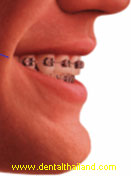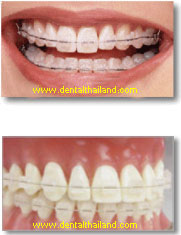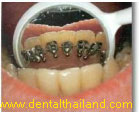|
|
 Orthodontic
Dentistry Orthodontic
Dentistry
|
Orthodontics are an excellent means
of correcting malpositioned teeth. They
can dramatically affect your appearance,
but importantly, orthodontics can
correct TMJ disorder as well as reduce
your susceptibility to dental decay and
periodontal disease.
Typically, orthodontic treatment
consists of the application of small
ceramic, or metal brackets to the
teeth. These brackets are attached to an
arch wire which helps shape the teeth.
Often springs and rubber bands are also
used to help move the teeth.
Treatment usually takes from one to
three years to complete. The amount of
time depends on the cooperation of the
patient and the difficulty of the
case. Once treatment is over, it may be
necessary to use a retainer for several
years; however, in some cases, a small
permanent retainer can be bonded to the
teeth.
FAQS
| Q |
When is the ideal time to seek treatment? |
| A |
The best age to do the orthodontic treatment is when you are twelve to thirteen years of age as all the permanent teeth have usually erupted by this stage. The jaws are growing at this age and so it is easier to expand your jaws and reshape your mouth.
However, it may be worth seeking advice even earlier. By the age of seven, enough permanent teeth have come in and enough jaw growth has occurred that the dentist or orthodontist can identify current problems, anticipate future problems or alleviate parents' concerns if all seems normal. |
| Q |
Am I too OLD for orthodontic treatment? |
| A |
There are no age limits! Orthodontic treatment can easily be done at an older age, if the dental and gingival condition is good. Most adults get orthodontic treatment because they realize that taking care of your smile is part of taking care of yourself.
 |
Metal Braces
 Metal braces (stainless steel) are the most popular type of braces used. Many patients enjoy having different colors placed on their braces as a means of personal expression and fun. Because it's so simple to change the colors, feel free to swap them at every visit. Metal braces (stainless steel) are the most popular type of braces used. Many patients enjoy having different colors placed on their braces as a means of personal expression and fun. Because it's so simple to change the colors, feel free to swap them at every visit.
Clear Braces
 Clear ceramic braces are an
aesthetic alternative for those
who don't want their braces to
show as much. Clear braces move
your teeth in exactly the same
way as metal braces do. Like
metal braces, they are extremely
comfortable to wear and very
efficient at moving teeth Clear ceramic braces are an
aesthetic alternative for those
who don't want their braces to
show as much. Clear braces move
your teeth in exactly the same
way as metal braces do. Like
metal braces, they are extremely
comfortable to wear and very
efficient at moving teeth
Lingual Braces

The difference is invisible
- Invisible Braces, the state-of-the-art
design that offers an amazing
technological advancement in orthodontic
treatment. These braces are behind some
of the most dazzling smiles that you see
everyday, and yet you probably never
noticed them. Lingual or Invisible
Braces are applied behind the teeth
| Q |
Are Lingual Braces more uncomfortable than conventional braces? |
| A |
Initial
discomfort is similar to that of
traditional braces. The
difference is that the Lingual
Braces will affect the tongue
and traditional braces will
affect the cheeks and lips.
Patients tend to take
approximately 1-4 weeks before
they achieve a reasonable
comfort level.
 |
| Q |
Are Lingual Braces expensive? |
| A |
Although
treatment time is similar,
lingual braces are more
expensive than traditional
braces. Special instrumentation,
equipment, doctor and staff
training are required for this
technique. The treatment is more
sophisticated and the personal
time and training required by
the orthodontist and his staff
is considerably greater.
 |
|
|
|
BSD Group
|